Classical FE Analysis to Classify Parkinson’s Disease Patients
Abstract
1. Introduction
2. Related Work
3. Contributions of This Work
4. Methods
4.1. Methodology
4.2. Participants and Data Collection
4.3. Multi-Task Cascaded Convolutional Networks
4.4. Local Binary Patterns
- The image color space is set to gray-scale.
- A radius hyper-parameter is chosen and the image is divided into cells.
- The central pixel of each cell is compared against its N neighbors. If the intensity of the center pixel is greater than or equal then a value of 1 is set in the neighbors’ position, otherwise, the value is set to 0.
- Starting clockwise from the top-right (Figure 7) a binary number is formed with the 1 s and 0 s from the previous step, this binary representation is then converted into decimal and stored in the central pixel position.
- With this new representation a feature histogram is formed.
- The process is repeated for each region and the histograms are concatenated forming the feature vector.
4.5. Histogram of Oriented Gradients
- The image color space is set to gray-scale.
- For each pixel in the image, the gradient is calculated in the x and y axes, generating and
- The magnitude and angle are calculated as shown in Equation (1):
- The gradient matrix is divided into cells where the histogram is calculated.
- Each histogram is normalized across local groups of cells using the normalization. This step is necessary to compensate for different changes in illumination and contrast between neighboring cells.
- An x-dimensional feature vector is computed across the resulting histograms.
4.6. Landmarks
4.7. Principal Component Analysis (PCA)
4.8. Support Vector Machine (SVM)
- Linear:
- Polynomial: , where d is the degree of the polynomial.
- Gaussian: , where is the kernel bandwidth.
- Sigmoid: , where r is a shifting parameter that controls the threshold of the mapping and is a scaling parameter for the input data [46].
5. Experiments and Results
5.1. Classification
5.2. Results
6. Discusion
7. Limitations and Constraints
8. Conclusions
Author Contributions
Funding
Institutional Review Board Statement
Informed Consent Statement
Data Availability Statement
Acknowledgments
Conflicts of Interest
References
- Rinn, W. The neuropsychology of facial expression: A review of the neurological and psychological mechanisms for producing facial expressions. Psychol. Bull. 1984, 95, 52–77. [Google Scholar] [CrossRef] [PubMed]
- Smith, M.C.; Smith, M.K.; Ellgring, H. Spontaneous and posed facial expression in Parkinson’s Disease. J. Int. Neuropsychol. Soc. 1996, 2, 383–391. [Google Scholar] [CrossRef] [PubMed]
- Bologna, M.; Fabbrini, G.; Marsili, L.; Defazio, G.; Thompson, P.D.; Berardelli, A. Facial bradykinesia. J. Neurol. Neurosurg. Psychiatry 2013, 84, 681–685. [Google Scholar] [CrossRef] [PubMed]
- Dargan, S.; Kumar, M.; Ayyagari, M.R.; Kumar, G. A Survey of Deep Learning and Its Applications: A New Paradigm to Machine Learning. Arch. Comput. Methods Eng. 2020, 27, 1071–1092. [Google Scholar] [CrossRef]
- Prakash, A.J.; Ari, S. A system for automatic cardiac arrhythmia recognition using electrocardiogram signal. Bioelectron. Med. Devices 2019, 2019, 891–911. [Google Scholar]
- Safi, K.; Fouad Aly, W.H.; AlAkkoumi, M.; Kanj, H.; Ghedira, M.; Hutin, E. EMD-Based Method for Supervised Classification of Parkinson’s Disease Patients Using Balance Control Data. Bioengineering 2022, 9, 283. [Google Scholar] [CrossRef]
- Schwartz, W.; Patil, R.; Szolovits, P. Artificial intelligence in medicine. Where do we stand? N. Engl. J. Med. 1987, 316, 685–688. [Google Scholar] [CrossRef]
- Deo, R.C. Machine Learning in Medicine. Circulation 2015, 132, 1920–1930. [Google Scholar] [CrossRef]
- LeCun, Y.; Bengio, Y.; Hinton, G. Deep learning. Nature 2015, 521, 436–444. [Google Scholar] [CrossRef]
- Canal, F.Z.; Müller, T.R.; Matias, J.C.; Scotton, G.G.; de Sa Junior, A.R.; Pozzebon, E.; Sobieranski, A.C. A survey on facial emotion recognition techniques: A state-of-the-art literature review. Inf. Sci. 2022, 582, 593–617. [Google Scholar] [CrossRef]
- Wang, H.; Huang, H.; Hu, Y.; Anderson, M.; Rollins, P.; Makedon, F. Emotion detection via discriminative kernel method. In Proceedings of the 3rd International Conference On Pervasive Technologies Related To Assistive Environments, Samos, Greece, 23–25 June 2010; pp. 1–7. [Google Scholar]
- Lyons, M.; Akamatsu, S.; Kamachi, M.; Gyoba, J. Coding facial expressions with gabor wavelets. In Proceedings of the Third IEEE International Conference on Automatic Face And Gesture Recognition, Nara, Japan, 14–16 April 1998; pp. 200–205. [Google Scholar]
- Zhao, G.; Huang, X.; Taini, M.; Li, S.Z.; PietikäInen, M. Facial expression recognition from near-infrared videos. Image Vis. Comput. 2011, 29, 607–619. [Google Scholar] [CrossRef]
- Zhong, L.; Liu, Q.; Yang, P.; Liu, B.; Huang, J.; Metaxas, D.N. Learning active facial patches for expression analysis. In Proceedings of the 2012 IEEE Conference on Computer Vision and Pattern Recognition, Providence, RI, USA, 16–21 June 2012; pp. 2562–2569. [Google Scholar]
- Lucey, P.; Cohn, J.; Kanade, T.; Saragih, J.; Ambadar, Z.; Matthews, I. The Extended Cohn-Kanade Dataset (CK+): A complete dataset for action unit and emotion-specified expression. In Proceedings of the 2010 IEEE Computer Society Conference on Computer Vision and Pattern Recognition-Workshops, San Francisco, CA, USA, 13–18 June 2010; pp. 94–101. [Google Scholar] [CrossRef]
- Shan, C.; Gong, S.; McOwan, P.W. Facial expression recognition based on local binary patterns: A comprehensive study. Image Vis. Comput. 2009, 27, 803–816. [Google Scholar] [CrossRef]
- Happy, S.; Routray, A. Automatic facial expression recognition using features of salient facial patches. IEEE Trans. Affect. Comput. 2014, 6, 1–12. [Google Scholar] [CrossRef]
- Eskil, M.T.; Benli, K.S. Facial expression recognition based on anatomy. Comput. Vis. Image Underst. 2014, 119, 1–14. [Google Scholar] [CrossRef]
- Viola, P.; Jones, M. Rapid object detection using a boosted cascade of simple features. In Proceedings of the 2001 IEEE Computer Society Conference On Computer Vision And Pattern Recognition, CVPR 2001, Kauai, HI, USA, 8–14 December 2001; Volume 1, p. I. [Google Scholar]
- Abeysundera, H.P.; Benli, K.S.; Eskil, M.T. Nearest neighbor weighted average customization for modeling faces. Mach. Vis. Appl. 2013, 24, 1525–1537. [Google Scholar] [CrossRef]
- Liu, Y.; Li, Y.; Ma, X.; Song, R. Facial expression recognition with fusion features extracted from salient facial areas. Sensors 2017, 17, 712. [Google Scholar] [CrossRef]
- Varma, S.; Shinde, M.; Chavan, S.S. Analysis of PCA and LDA features for facial expression recognition using SVM and HMM classifiers. In Techno-Societal 2018; Springer: Berlin/Heidelberg, Germany, 2020; pp. 109–119. [Google Scholar]
- Reddy, C.V.R.; Reddy, U.S.; Kishore, K.V.K. Facial emotion recognition using NLPCA and SVM. Trait. Signal 2019, 36, 13–22. [Google Scholar] [CrossRef]
- Nazir, M.; Jan, Z.; Sajjad, M. Facial expression recognition using histogram of oriented gradients based transformed features. Clust. Comput. 2018, 21, 539–548. [Google Scholar] [CrossRef]
- Acevedo, D.; Negri, P.; Buemi, M.E.; Fernández, F.G.; Mejail, M. A simple geometric-based descriptor for facial expression recognition. In Proceedings of the 2017 12th IEEE International Conference on Automatic Face & Gesture Recognition (FG 2017), Washington, DC, USA, 30 May–3 June 2017; pp. 802–808. [Google Scholar]
- Chaabane, S.B.; Hijji, M.; Harrabi, R.; Seddik, H. Face recognition based on statistical features and SVM classifier. Multimed. Tools Appl. 2022, 81, 8767–8784. [Google Scholar] [CrossRef]
- Bhangale, K.B.; Jadhav, K.M.; Shirke, Y.R. Robust pose invariant face recognition using DCP and LBP. Int. J. Manag. Technol. Eng. 2018, 8, 1026–1034. [Google Scholar]
- Eng, S.; Ali, H.; Cheah, A.; Chong, Y. Facial expression recognition in JAFFE and KDEF Datasets using histogram of oriented gradients and support vector machine. In Proceedings of the IOP Conference Series: Materials Science And Engineering; IOP Publishing: Bristol, UK, 2019; Volume 705, p. 012031. [Google Scholar]
- Bandini, A.; Orlandi, S.; Escalante, H.J.; Giovannelli, F.; Cincotta, M.; Reyes-Garcia, C.A.; Vanni, P.; Zaccara, G.; Manfredi, C. Analysis of facial expressions in parkinson’s disease through video-based automatic methods. J. Neurosci. Methods 2017, 281, 7–20. [Google Scholar] [CrossRef] [PubMed]
- Langner, O.; Dotsch, R.; Bijlstra, G.; Wigboldus, D.H.J.; Hawk, S.T.; van Knippenberg, A. Presentation and validation of the Radboud Faces Database. Cogn. Emot. 2010, 24, 1377–1388. [Google Scholar] [CrossRef]
- Rajnoha, M.; Mekyska, J.; Burget, R.; Eliasova, I.; Kostalova, M.; Rektorova, I. Towards Identification of Hypomimia in Parkinson’s Disease Based on Face Recognition Methods. In Proceedings of the 2018 10th International Congress on Ultra Modern Telecommunications and Control Systems and Workshops (ICUMT), Moscow, Russia, 5–9 November 2018; pp. 1–4. [Google Scholar] [CrossRef]
- Grammatikopoulou, A.; Grammalidis, N.; Bostantjopoulou, S.; Katsarou, Z. Detecting hypomimia symptoms by selfie photo analysis: For early Parkinson disease detection. In Proceedings of the 12th ACM International Conference on PErvasive Technologies Related to Assistive Environments, Island of Rhodes, Greece, 5–7 June 2019; pp. 517–522. [Google Scholar]
- Goetz, C.G.; Tilley, B.C.; Shaftman, S.R.; Stebbins, G.T.; Fahn, S.; Martinez-Martin, P.; Poewe, W.; Sampaio, C.; Stern, M.B.; Dodel, R.; et al. Movement Disorder Society-sponsored revision of the Unified Parkinson’s Disease Rating Scale (MDS-UPDRS): Scale presentation and clinimetric testing results. Mov. Disord. Off. J. Mov. Disord. Soc. 2008, 23, 2129–2170. [Google Scholar] [CrossRef] [PubMed]
- Jin, B.; Qu, Y.; Zhang, L.; Gao, Z. Diagnosing Parkinson disease through facial expression recognition: Video analysis. J. Med. Internet Res. 2020, 22, e18697. [Google Scholar] [CrossRef] [PubMed]
- Gómez-Gómez, L.F.; Morales, A.; Fierrez, J.; Orozco-Arroyave, J.R. Exploring Facial Expressions and Action Unit Domains for Parkinson Detection. SSRN 2022. [Google Scholar] [CrossRef]
- Ali, M.R.; Myers, T.; Wagner, E.; Ratnu, H.; Dorsey, E.; Hoque, E. Facial expressions can detect Parkinson’s disease: Preliminary evidence from videos collected online. NPJ Digit. Med. 2021, 4, 1–4. [Google Scholar] [CrossRef]
- Langevin, R.; Ali, M.R.; Sen, T.; Snyder, C.; Myers, T.; Dorsey, E.R.; Hoque, M.E. The PARK framework for automated analysis of Parkinson’s disease characteristics. Proc. ACM Interact. Mob. Wearable Ubiquitous Technol. 2019, 3, 1–22. [Google Scholar] [CrossRef]
- Zhang, K.; Zhang, Z.; Li, Z.; Qiao, Y. Joint face detection and alignment using multitask cascaded convolutional networks. IEEE Signal Process. Lett. 2016, 23, 1499–1503. [Google Scholar] [CrossRef]
- Dalal, N.; Triggs, B. Histograms of oriented gradients for human detection. In Proceedings of the 2005 IEEE Computer Society Conference On Computer Vision And Pattern Recognition (CVPR’05), San Diego, VA, USA, 20–25 June 2005; Volume 1, pp. 886–893. [Google Scholar]
- Dryden, I.L.; Mardia, K.V. Statistical Shape Analysis: With Applications in R; John Wiley & Sons: Hoboken, NJ, USA, 2016; Volume 995. [Google Scholar]
- Shi, J.; Samal, A.; Marx, D. How effective are landmarks and their geometry for face recognition? Comput. Vis. Image Underst. 2006, 102, 117–133. [Google Scholar] [CrossRef]
- Kazemi, V.; Sullivan, J. One millisecond face alignment with an ensemble of regression trees. In Proceedings of the IEEE Conference On Computer Vision And Pattern Recognition, Washington, DC, USA, 23–28 June 2014; pp. 1867–1874. [Google Scholar]
- Xu, Y.; Zhang, D.; Yang, J.Y. A feature extraction method for use with bimodal biometrics. Pattern Recognit. 2010, 43, 1106–1115. [Google Scholar] [CrossRef]
- Schölkopf, B.; Smola, A.J.; Bach, F. Learning with Kernels: Support Vector Machines, Regularization, Optimization, And Beyond; MIT Press: Cambridge, MA, USA, 2002. [Google Scholar]
- Soentpiet, R. Advances in Kernel Methods: Support Vector Learning; MIT Press: Cambridge, MA, USA, 1999. [Google Scholar]
- Lin, H.T.; Lin, C.J. A study on sigmoid kernels for SVM and the training of non-PSD kernels by SMO-type methods. Neural Comput. 2003, 3, 16. [Google Scholar]

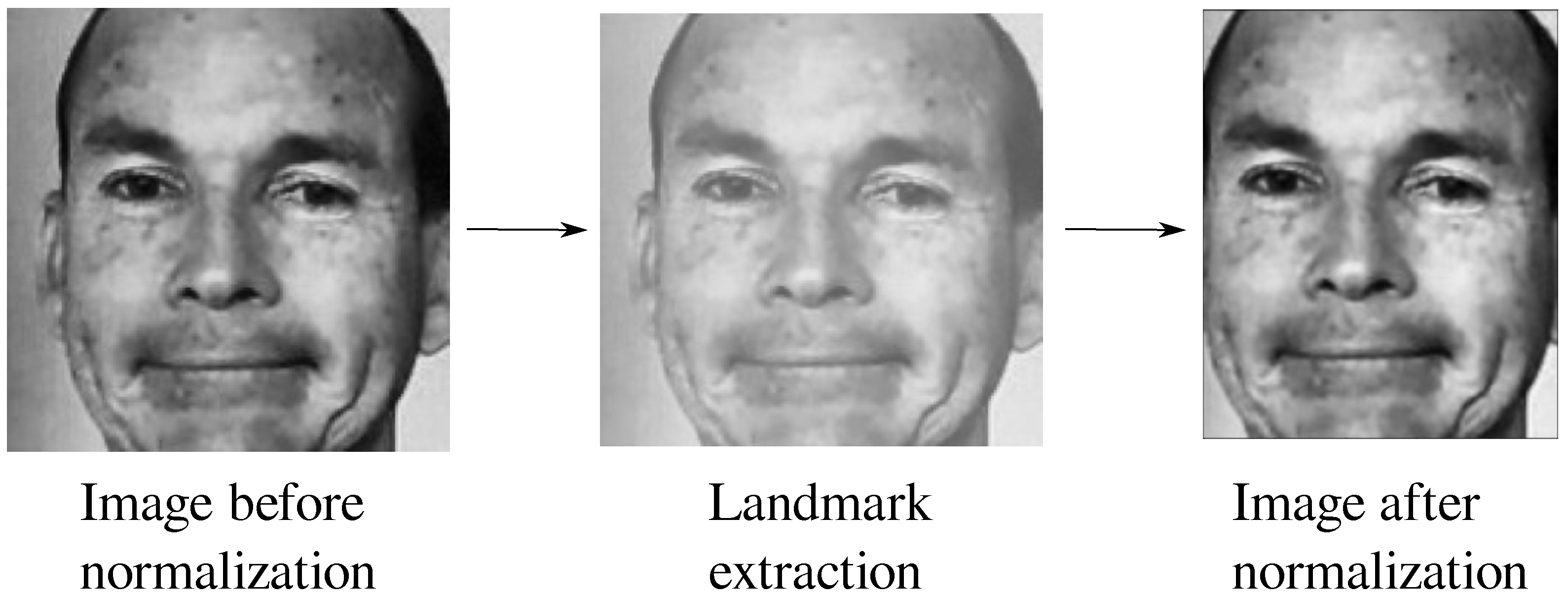
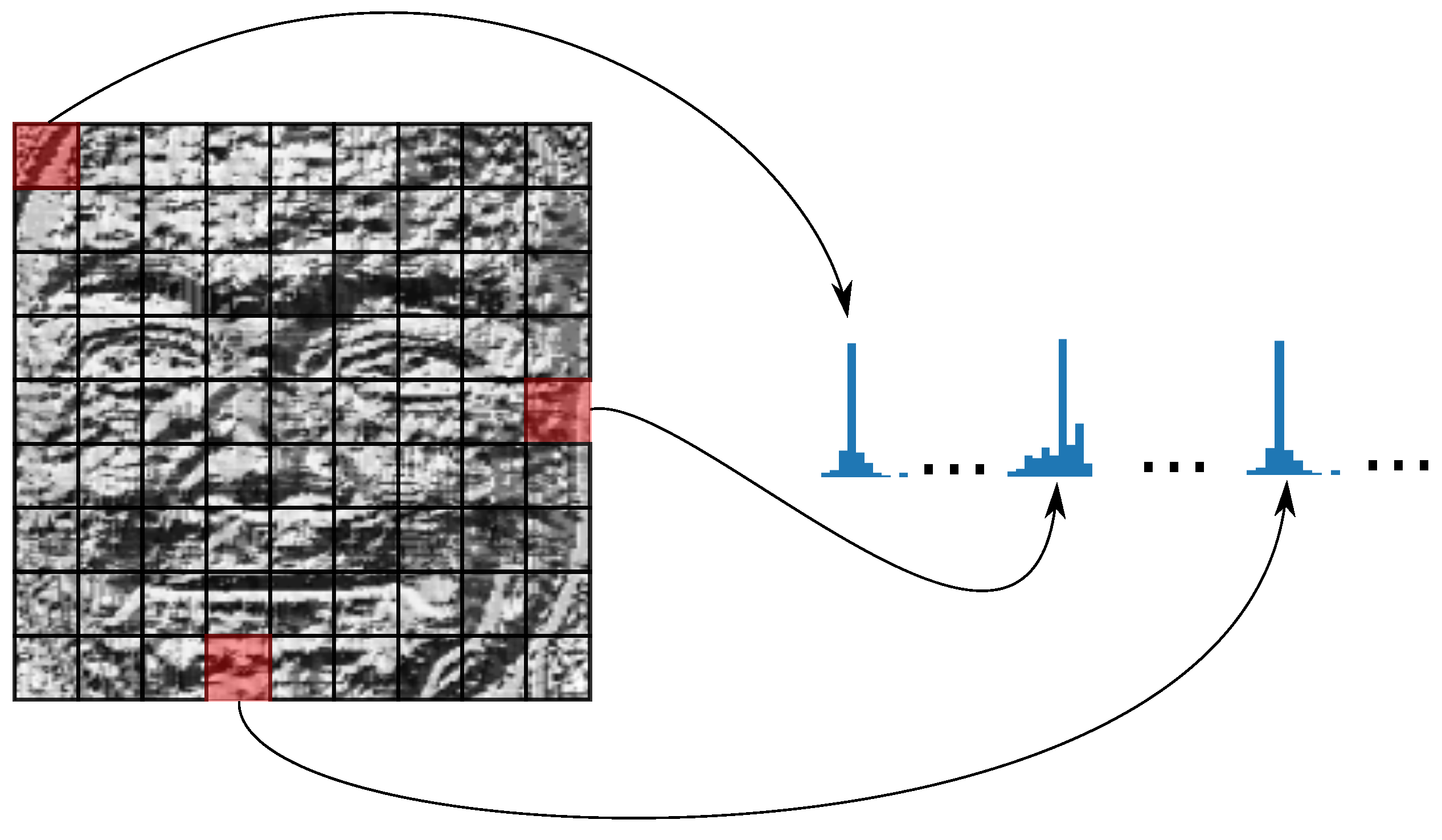
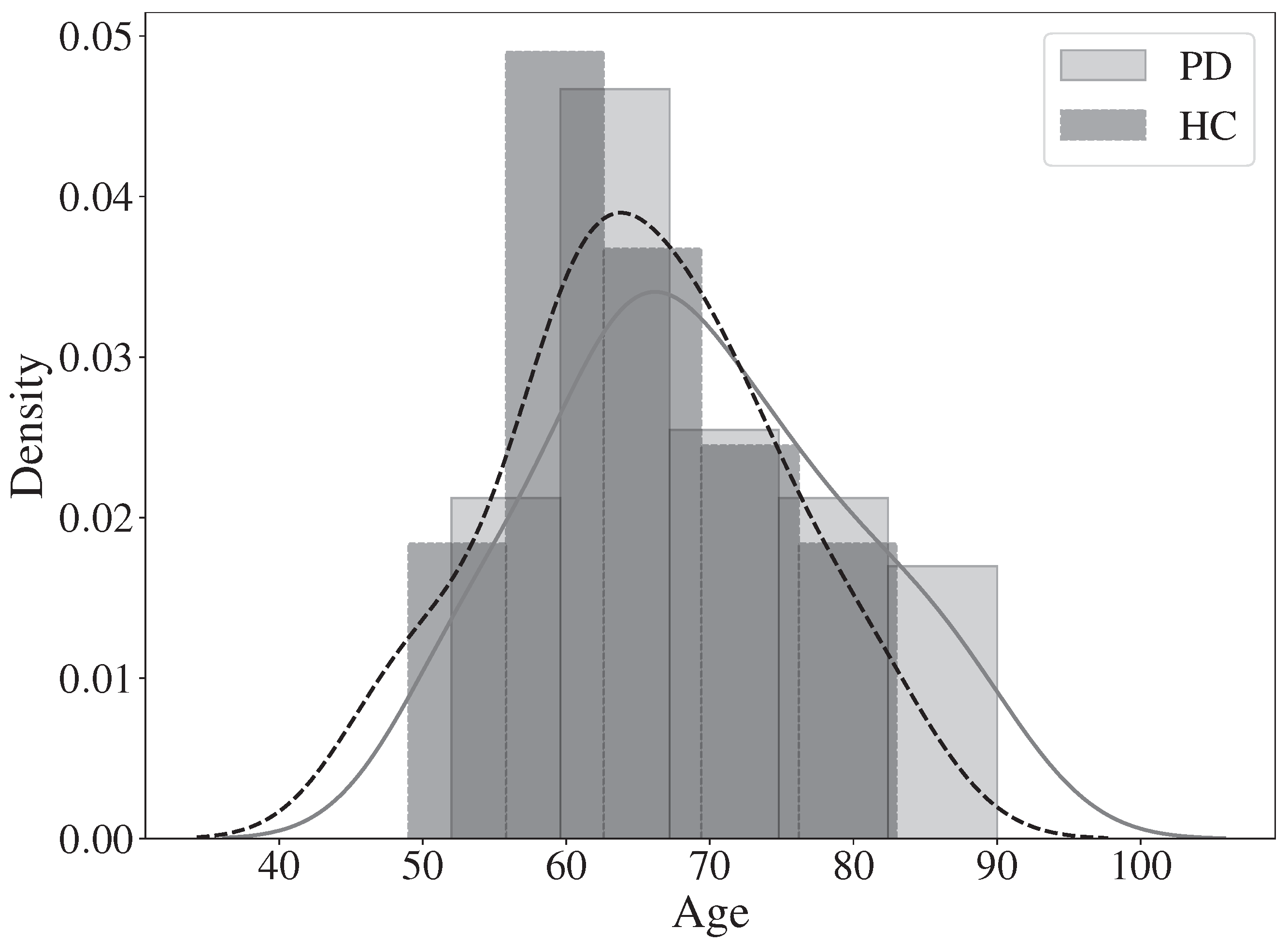
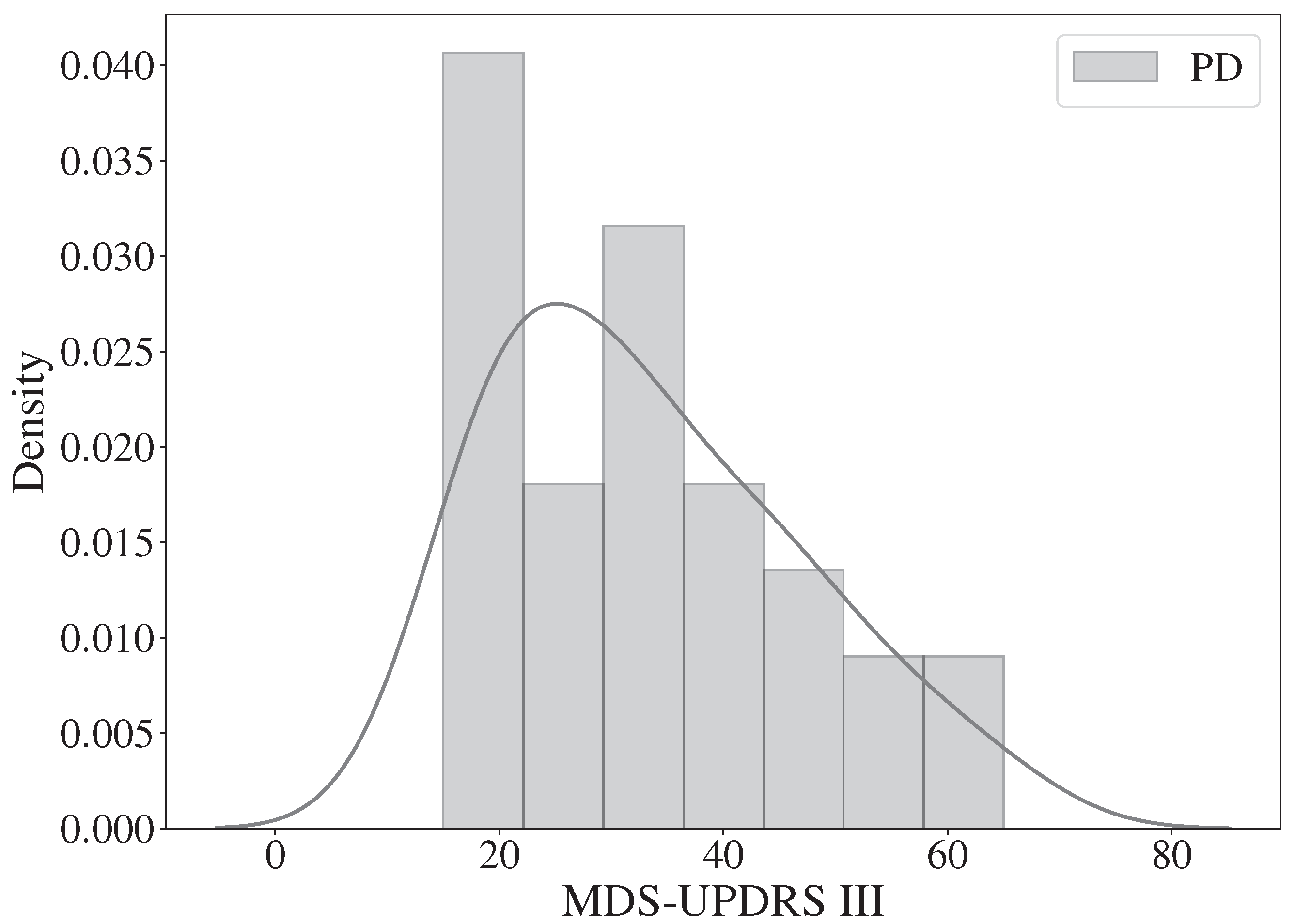
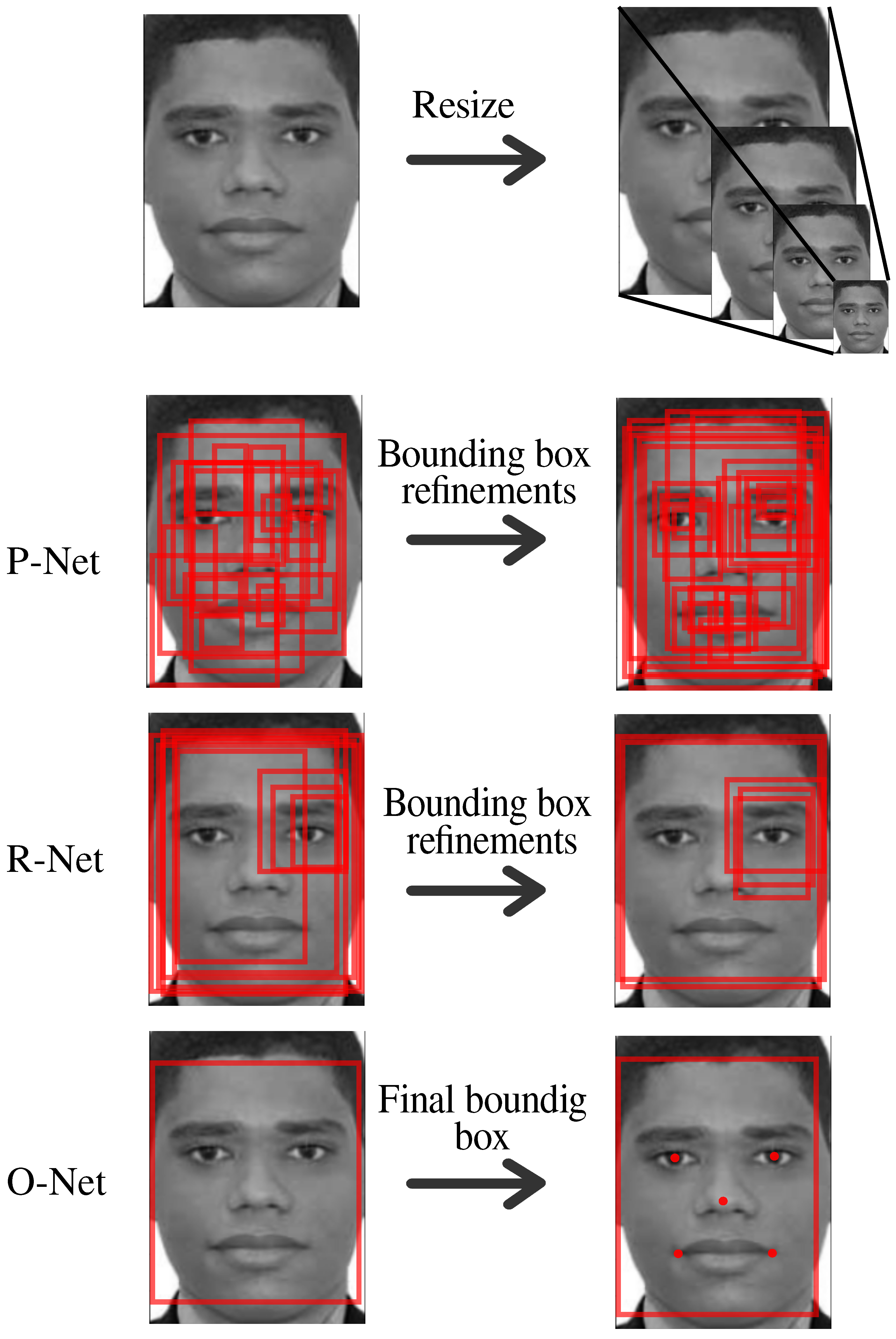


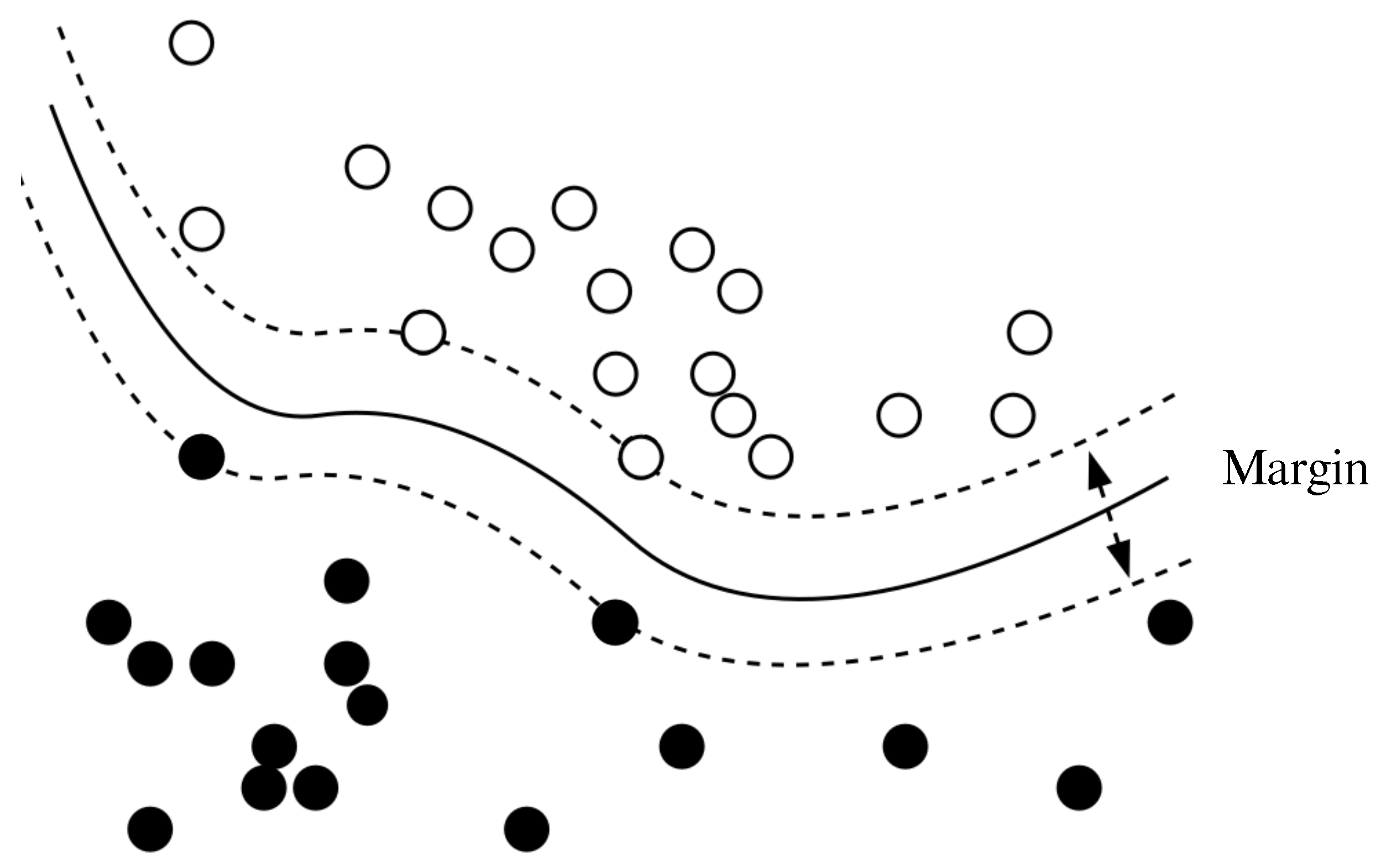
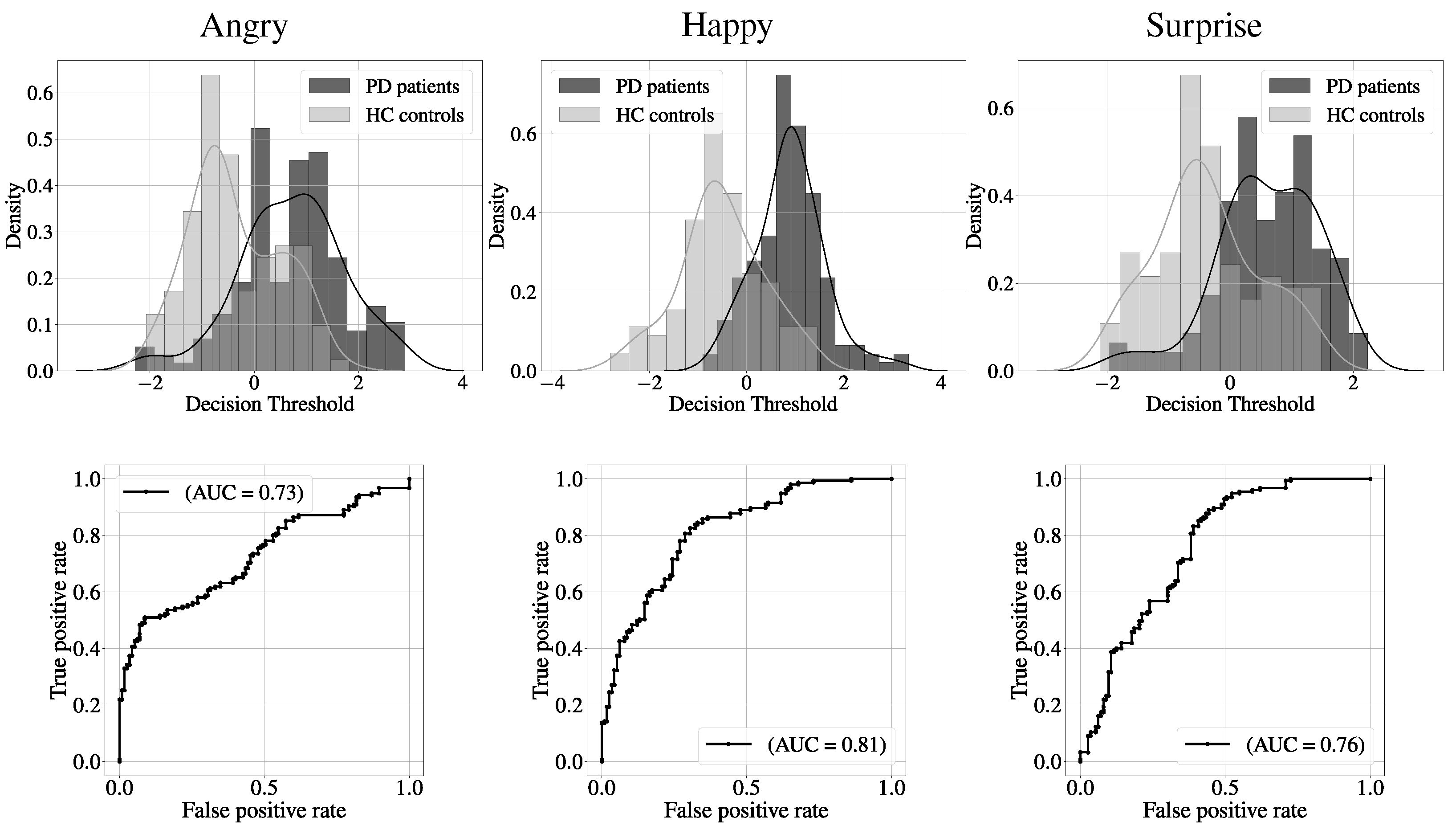

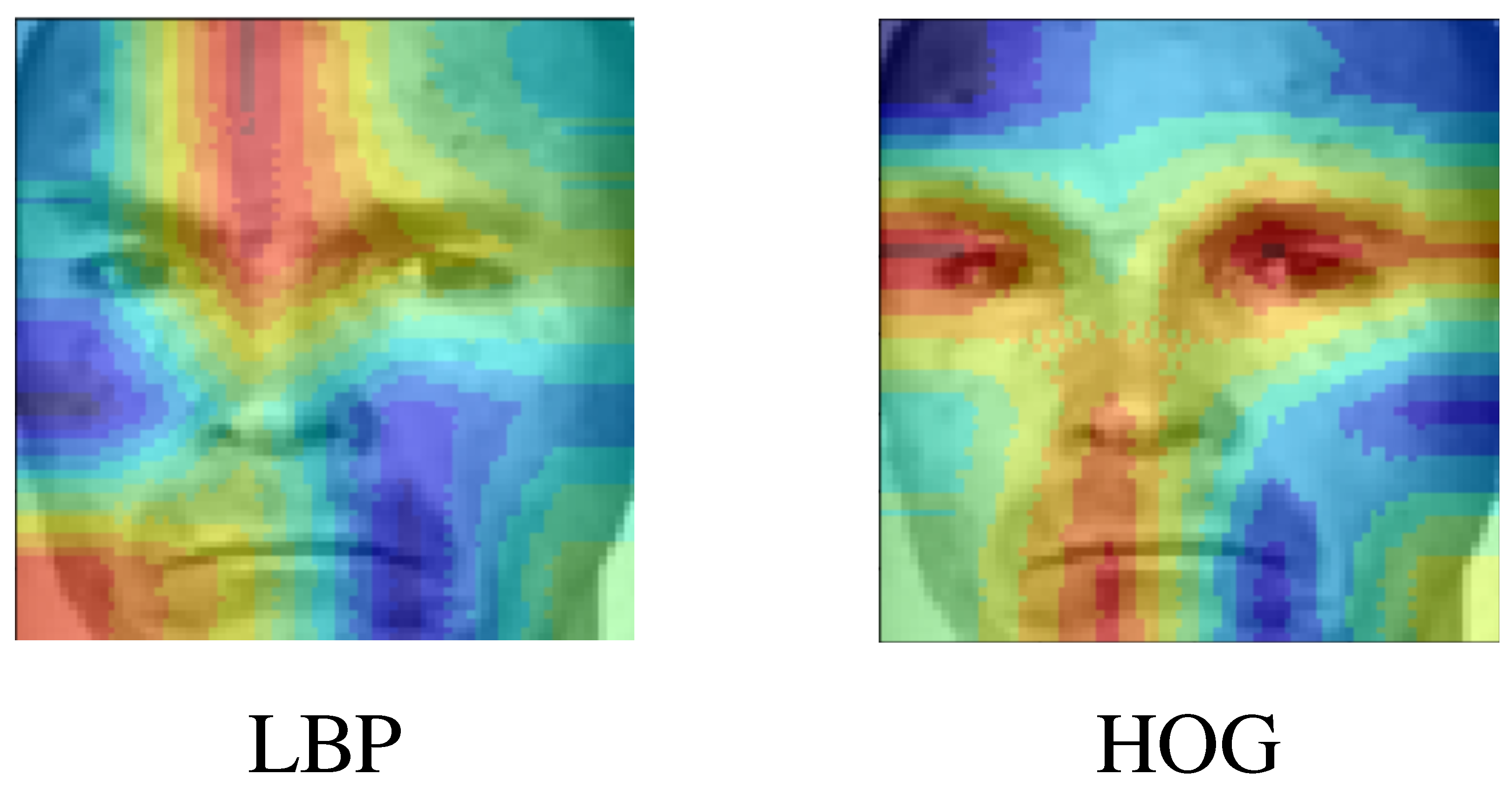
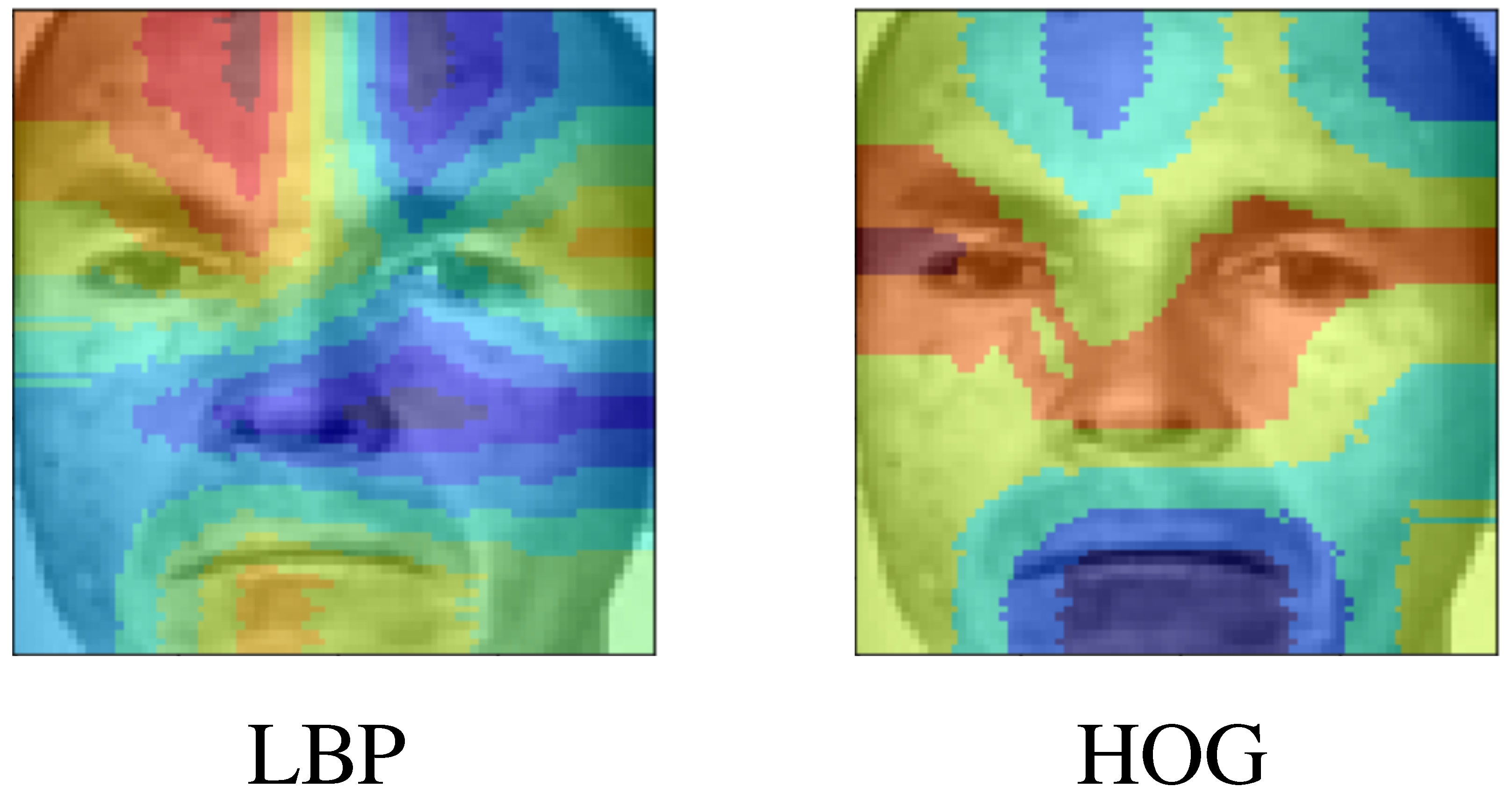

| PD Patients | HC Subjects | |||
|---|---|---|---|---|
| Men | Women | Men | Women | |
| # of participants | 19 | 12 | 12 | 12 |
| Age | ||||
| Age range | 52–90 | 53–87 | 49–80 | 49–83 |
| Time since diagnosis | − | − | ||
| Range time since diagnosis | 2–20 | 1–45 | − | − |
| MDS-UPDRS-III | − | − | ||
| Feature | Classifier | ACC | SEN | SPE |
|---|---|---|---|---|
| LBP | SVM: C = 0.001, kernel = linear | 72.8 | 75.8 | 68.3 |
| HOG | SVM: C = 0.1, kernel = linear | 66.1 | 88.0 | 37.8 |
| Feature | Classifier | ACC | SEN | SPE |
|---|---|---|---|---|
| LBP | SVM: C = 0.001, kernel = linear | 80.4 | 84.6 | 74.6 |
| HOG | SVM: C = 0.1, kernel = linear | 62.1 | 79.6 | 41.0 |
| Feature | Classifier | ACC | SEN | SPE |
|---|---|---|---|---|
| LBP | SVM: SVM: C = 0.001, kernel = linear | 75.8 | 80.1 | 70.6 |
| HOG | SVM: SVM: C = 0.1, kernel = linear | 64.9 | 75.6 | 51.4 |
| Emotion | p-Value (Mann-Whitney U Test) | |
|---|---|---|
| Angry | 3.81 × 10 | Rejected |
| Happiness | 3.23 × 10 | Rejected |
| Surprise | 1.35 × 10 | Rejected |
Publisher’s Note: MDPI stays neutral with regard to jurisdictional claims in published maps and institutional affiliations. |
© 2022 by the authors. Licensee MDPI, Basel, Switzerland. This article is an open access article distributed under the terms and conditions of the Creative Commons Attribution (CC BY) license (https://creativecommons.org/licenses/by/4.0/).
Share and Cite
Calvo-Ariza, N.R.; Gómez-Gómez, L.F.; Orozco-Arroyave, J.R. Classical FE Analysis to Classify Parkinson’s Disease Patients. Electronics 2022, 11, 3533. https://doi.org/10.3390/electronics11213533
Calvo-Ariza NR, Gómez-Gómez LF, Orozco-Arroyave JR. Classical FE Analysis to Classify Parkinson’s Disease Patients. Electronics. 2022; 11(21):3533. https://doi.org/10.3390/electronics11213533
Chicago/Turabian StyleCalvo-Ariza, Nestor Rafael, Luis Felipe Gómez-Gómez, and Juan Rafael Orozco-Arroyave. 2022. "Classical FE Analysis to Classify Parkinson’s Disease Patients" Electronics 11, no. 21: 3533. https://doi.org/10.3390/electronics11213533
APA StyleCalvo-Ariza, N. R., Gómez-Gómez, L. F., & Orozco-Arroyave, J. R. (2022). Classical FE Analysis to Classify Parkinson’s Disease Patients. Electronics, 11(21), 3533. https://doi.org/10.3390/electronics11213533







